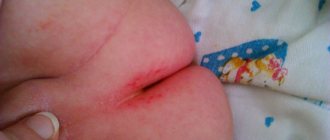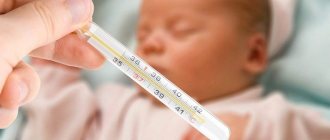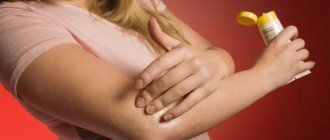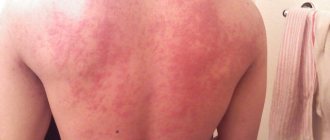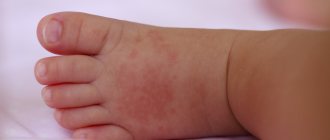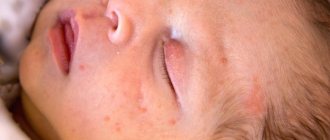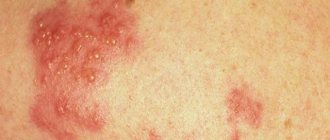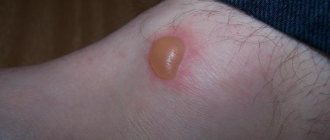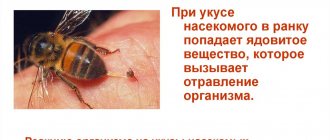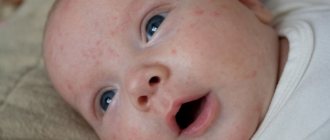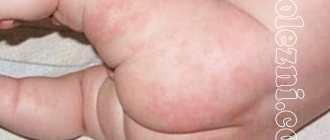Causes
A rash on the arms and legs can appear for various reasons, for example, due to infectious skin lesions, allergies, and even problems with the circulatory system. In this case, the disease may first affect the limbs and gradually spread throughout the body.
Infection
A skin rash can appear as a sign of some infectious diseases, for example, chickenpox, rubella, scarlet fever, measles, meningococcus. All these diseases are considered quite dangerous if left untreated, and can not only provoke the appearance of painful ulcers on the skin, but also complications on internal organs.
Also, rashes may appear on the skin of the hands and feet when infected with a fungal infection. In this case, the disease mycosis develops, in which painful and itchy blisters will appear on the skin. Over time, the blisters burst, leaving behind painful wounds, the skin becomes rough and peels.
Infectious dermatitis can affect any area of the skin, and in some diseases, red spots and painful blisters appear throughout the body. Even if the blisters are localized only on the palms and soles, and the disease does not progress, you should still not self-medicate, as there is a risk of complications.
Allergy
Often, small rashes and irritation appear on the hands and feet of young children as the body reacts to various allergens that enter it. Substances that cause the rash can be excreted in breast milk if the nursing mother does not follow a diet, and a reaction to various foods that the baby eats himself is also possible.
The fact is that the child’s body is not perfect, and until a certain time it cannot digest a large amount of substances and painlessly remove them from the body, as a result, the accumulation of substances that the small body cannot cope with manifests itself in a rash.
With allergies, the rash can be located anywhere, including on the palms and soles, usually between the fingers. In this case, small pimples can itch very much and bother the baby, he becomes capricious, sleeps poorly and constantly tries to scratch his itchy limbs.
Parasites
Children are constantly in contact with each other, get very dirty and can become infected with scabies mites; these parasites penetrate the skin, causing the appearance of a small reddish rash that itches terribly. Most often, the disease begins in the hands: small itchy pimples appear on the palms and between the fingers.
Over time, the disease can progress, then the rash gradually spreads, mites can lay eggs in the head area and throughout the body. Itching is caused by the fluid that the mite secretes as it moves under the skin. It is also worth noting that scabies is a very contagious disease; one contact with an infected individual is enough to cause you to get sick too.
Vessels
Rash caused by pathology of the vascular system
A hemorrhagic rash on the palms and soles can appear when the circulatory system is disrupted; it does not cause inflammation, but spots and stripes of varying sizes may appear on the skin. This rash occurs when capillaries and blood vessels are destroyed, red blood cells leak through the gap and form dark spots.
A hemorrhagic rash in itself does not bring any discomfort to the child, but it may indicate that serious disturbances have occurred in the body. Therefore, if you notice such rashes in a child, you need to urgently call an ambulance or take the baby to the doctor yourself.
Poor hygiene
Children of all ages can develop rashes due to poor hygiene. Miliaria often occurs if the child is not washed in time, and if the baby crawls on the ground all day and his hands are not washed, even dangerous ulcers may appear. In addition, poor hygiene can provoke infection in the body, then dermatitis due to the disease cannot be avoided.
Blisters on the palms
A person may suddenly feel the urge to scratch their arms. This is due to the fact that a large number of nerve endings are located in this area. Usually discomfort is detected when blisters appear on the palms.
Rashes can form for various reasons. To establish them, you need to contact a dermatologist.
Allergic reaction
The appearance of blisters that itch may be due to the development of an allergic reaction in the body. The itching can be mild or severe. Typically, food products, medications, and insect bites act as irritants.
The affected areas become covered with rashes both immediately upon contact with the irritant and after some time. Depending on the strength of the impact, a weakening or intensification of symptoms is noted.
You can cope with such signs by eliminating the irritant. You can get rid of blisters on your palms by taking antihistamines.
Insect bites
Watery blisters appear when insects bite. Red formations are usually very itchy and painful, causing severe discomfort to the person.
Coping with the consequences of bites is not difficult. They may go away on their own without treatment in a few days.
You can often observe the consequences of bites from wasps, hornets, ticks, mosquitoes, fleas, midges, bees, horseflies, bedbugs, and spiders on your hands. In rare cases, a person may develop a severe allergic reaction. It manifests itself in the form of anaphylaxis, in which there is difficulty breathing, dizziness, and swelling of the face. Such symptoms require emergency medical attention.
A thermal burn is characterized by large, watery blisters.
When the skin is affected by midges, small red, painful pimples appear. Situations in which severe swelling and swelling develop are alarming.
Bedbugs often bite not only your hands, but also your face and neck. You can also see the affected areas on the feet. The formations persist for several days.
Burn
If a person touches a hot object with his hands, a thermal burn may occur. After this, bubbles with liquid form on the surface of the skin.
If the blisters open, a wound surface is formed. Therefore, it is dangerous to injure formations, especially at the first stage after their appearance. There is also a high chance of wound infection.
If all rules are followed, healing occurs quickly. If you manage to avoid the penetration of viruses or bacteria, then the formation is completely eliminated in 14 days.
The spread of infection can be determined by the cloudiness of the contents inside the blister. The skin also begins to turn red. In this case, it is necessary to open the formation under sterile conditions in a medical facility.
When the body is affected by infections, a person becomes dangerous to others. Blisters on the palms of a child and an adult may indicate the development of pathogenic microflora in the subcutaneous tissues. In this case, when touched, microorganisms can penetrate small wounds and cracks in the skin of a healthy person and provoke an inflammatory process.
There are several common diseases that lead to the appearance of blisters with fluid. These include:
Bubbles may vary in size. The size varies from small, like a grain, to large suppurations.
The disease can manifest in children and adolescents. But doctors often have to treat adult patients for infectious diseases.
In addition to the rash, there are other signs of the disease. The patient's body temperature rises and weakness appears.
For scabies, the use of Spregal spray is indicated
If your palm itches and small rashes appear, you can assume ringworm. Doctors call the disease dermatomycosis. A fungus acts as a provoking factor.
Usually you can cope with the lesion yourself with local medications. But severe cases of the disease require the use of antibiotics.
If the tissues are affected by the mite, subcutaneous formations appear between the fingers and on the palms. In this case, an inflammatory process develops, accompanied by the formation of nodules.
Dermatologists note that scabies is very difficult to cure. Itching may remain for a month or more after mite penetration. Even after eliminating the parasites, discomfort may persist.
Scabies is treated with sulfur ointment, Spregal spray. You can also use folk remedies: garlic, vinegar, tar soap, turpentine.
Dyshidrotic eczema can develop under the influence of external and internal factors
Dyshidrotic eczema is a form of dermatitis. It is characterized by the appearance of a rash and itching in the palms, fingers, and soles of the feet.
The disease can be provoked by:
- fungal infections;
- chemical substances;
- stressful situations;
- dry skin;
- allergic reaction.
There is no need to treat this disease on your own. It is important that therapy is prescribed by a doctor. It is carried out comprehensively. Additionally, physical treatment in the form of acupuncture, UHF, mud therapy, and laser treatment may be required.
Painful blisters on the palms, soles and throughout the body may indicate the development of a serious pathology. Pemphigus is an autoimmune disease. It is more popularly known as pemphigus.
When such a disease occurs, the immune cells themselves attack the cells. Both the skin and the mucous membrane are affected. The reasons why such disorders occur in the body still remain unknown.
You can also read:What to do if blisters appear after sunbathing
Dermatitis herpetiformis has a similar nature. It manifests itself in the form of rashes on the fingers, toes, and other parts of the body.
Men aged 15 to 60 years are predisposed to the development of pathology.
It appears when:
- pathologies of the gastrointestinal tract;
- ascariasis;
- viral diseases;
- genetic predisposition.
At the initial stage, red lesions appear. Later they transform into watery formations under the skin. Localized mainly in the palm area. These areas often swell.
If the rash is severe and does not go away on its own, you should definitely consult a doctor.
When infection penetrates, the internal contents become cloudy. In this case, the blisters can become ulcers. After they open, a crust or ulcer appears. The formations are accompanied by severe itching, burning, and a rise in body temperature.
Is it necessary to see a doctor?
Some rashes can be treated on your own. For example, self-medication is available if the bladder has a traumatic origin. A mosquito bite or thermal burn is treated with medications and folk remedies.
But if the blisters are caused by an infection or are of an autoimmune nature, then the help of a doctor is required. In this case, you need to contact an allergist or dermatologist.
In severe cases, treatment is with corticosteroids
It is important to diagnose infectious diseases in a timely manner. After all, chicken pox, lupus erythematosus, herpes, scarlet fever, dyshidrosis require competent comprehensive treatment. It is imperative to visit a medical facility if:
- no obvious cause for the rash;
- an increase in the number of rashes despite treatment;
- violation of the integrity of blisters;
- skin irritation, inflammation and redness;
- the release of pus from the cracks, bleeding of the wound, increased pain.
Prohibited actions
Some actions are prohibited when blistering rashes appear. Thus, during processing there is no need to use alcohol solutions or the substance in its pure form. They can be aggressive on the skin.
Among the inappropriate actions are:
- scratching blisters;
- squeezing out their contents;
- opening of formations.
As a result of these actions, pathogenic bacteria can enter the wound. A purulent process may develop, phlegmon may appear, and the lymph nodes may become inflamed.
With the appearance of blisters, a person needs to restore the condition of the skin as soon as possible and cope with the itching. This can be done by following some first aid measures.
- If the rash is the result of a chemical attack, then it is necessary to rinse the skin with plenty of running water.
- Apply a cold compress to the affected skin.
- You can use aloe juice. It is also recommended to cut off the leaf and, after removing the skin, apply a bandage to the blisters.
- To eliminate itching, Akriderm, Sinaflan, and Fenistil-gel ointments are used.
- Bubbles must be sealed with a bandage or covered with a bandage. In this case, they will not burst, and the infection will not be able to penetrate.
The blistered palm must be covered with a plaster or bandaged.
Treatment with pharmaceutical drugs
Liquid blisters are eliminated with the help of antibacterial external agents Levomekol, Vishnevsky liniment, Dermazin. Healing ointments, for example, Panthenol, are also highly effective. They need to be applied twice a day to the affected areas. An important feature is the ability to use both before and after opening the formations.
All drugs act in two directions. They eliminate harmful microorganisms that cause the development of the inflammatory process. In this case, tissue healing occurs, due to which the integument is quickly restored.
An allergic reaction can be eliminated with the mandatory use of antihistamines
If an allergic reaction develops, antihistamines are prescribed. They relieve itching by blocking the production of histamine. During periods of severe symptoms, you can take Zyrtec, Telfast, Zodak, Erius.
To eliminate swelling and restore the condition of the skin, corticosteroids can be prescribed. They are recommended for use in the event of a severe allergic reaction. Patients are often prescribed ointments Sinaflan, Lokoid, Advantan.
In case of an insect bite, the same medications are prescribed as for allergies. After all, the poison contains histamine, which provokes a negative reaction. The affected areas can be lubricated with Asterisk or Rescuer.
Folk recipes
Some folk recipes will help you cope with blisters. It is better to use them after the cause of the violations is determined.
The skin must be constantly washed with laundry soap. It disinfects tissues and dries blisters. It is especially important to carry out procedures before using medicinal compounds.
You can take yarrow infusion internally. 30 g of herb is brewed with 200 g of boiling water. After infusing and straining for half an hour, you need to drink 50 g four times a day.
Calendula flowers are brewed in a similar way. The decoction is taken one tablespoon three times a day.
The palms are in constant contact with various objects. To prevent blisters from bursting and wounds becoming infected, you need to promptly find out the cause of their occurrence and undergo a treatment course.
Source: https://postpk.ru/zdorovye/voldyri-ladonyah
On foot
A rash on the legs and feet can appear in all the cases listed above, in addition, diaper dermatitis often appears on the thighs of children. Its cause is constant wearing of diapers, while the skin becomes dry and inflamed. If you do not wash your baby in a timely manner, feces and urine will corrode his skin.
A rash on the legs and feet may appear for the following reasons:
- When overheated;
- With poor hygiene;
- For psoriasis;
- For infectious diseases;
- For insect and parasite bites;
- For fungal skin infections.
Dyshidrosis
When a child develops a rash on the feet and palms, which manifests itself in the form of specific blisters filled with fluid, this may be a signal that dyshidrosis has developed. This is an infectious disease that affects the skin of the feet and hands.
READ ALSO: Small watery pimples on the hand and fingers itch: causes and treatment
Pediatricians advise monitoring the child’s condition especially closely in the spring and summer. In the hot season, relapses of the disease occur much more often and are associated with blockage of the sebaceous glands. Excessive sweating can cause dyshidrosis in a baby.
Experts identify several factors influencing the development of pathology:
- excessive sweating;
- frequent exciting situations, stress;
- fungal diseases of the dermis;
- heredity;
- diseases of the endocrine system;
- gastrointestinal pathologies;
- allergy.
According to medical statistics, a child susceptible to atopic dermatitis and diathesis is more likely to suffer dyshidrosis.
Dr. Komarovsky believes that the cause of the development of the disease is an allergic reaction of the digestive system, so it is necessary to introduce a new product into the children's diet with caution. If the child is bottle-fed, it is worth replacing the milk formula with another one with a lower concentration.
It is necessary to know the main symptoms of the pathology in order to recognize the disease in time and take measures to eliminate it.
- Dyshidrosis manifests itself in the form of a rash; it most often affects the palms, inner surfaces of the fingers on the upper and lower extremities, and feet.
- At the initial stage, the child notices an uncomfortable tingling sensation in the area of the palms and feet. This leads to the baby starting to scratch the affected skin, resulting in a rash. It begins to cause itching and burning.
- Redness and specific balls and blisters appear on the dermis, which itch and fill with fluid.
- The bubbles are small in size and reach only a few millimeters. They have a transparent tint, but the skin around them becomes red due to constant scratching.
- Over the course of a week, a maximum of 10 days, the rash on the palms and feet goes away. They may open on their own or dry out. In this case, the healing process is accompanied by unpleasant sensations: swelling occurs, erosions appear in place of former blisters, and the dermis becomes painful.
- Finally, the skin begins to peel off. When using special means, the disease is eliminated from this moment in a few days.
READ ALSO: Pimples on the back of the head in men: causes, symptoms, diagnosis and treatment
Parents should remember that true dyshidrosis is distinguished by the absence of new blisters. After self-opening of the rash, no new manifestations should appear. The baby may develop dry dyshidrosis, which is characterized by the absence of the stage of bubbles with liquid, and the peeling stage immediately begins.
Treatment of pathology is not difficult if you consult a specialist in time.
Pediatricians often prescribe a specific therapeutic regimen consisting of antihistamine medications: Suprastin, Fenistil, Diazolin. Sorbent drugs (Activated carbon, Smecta, Enterosgel, Enterosorb) and sedatives that can be used in childhood are included: for example, Valerian. Sometimes the doctor prescribes additional medications or vitamin complexes for calcium levels.
For external use, antimicrobial drugs with a drying effect are prescribed: Brilliant Green solution, Fukortsin. Also, products that can quickly dry out rashes include: Sudocrem, Furacilin solution, zinc ointment. A prerequisite is the use of corticosteroid medications: Dermovate, Sinaflan, Lorinden, Flucinar. It is not recommended to use these drugs directly; a small amount of ointment should be added to baby cream and applied in moderation to the skin.
READ ALSO: Etiology and Pathogenesis of Lipoma
Symptoms
To determine how soon you need to see a doctor if your child has a rash, you need to pay attention to the following factors:
- Does the rash bother your child? If it bothers you, the baby will probably be capricious, he may sleep poorly and refuse to eat, and a child under 6 months may crawl in the crib all the time, trying to relieve the itching.
- What is the child's temperature? In children under one year of age, a temperature of 37 is considered normal, but if the temperature rises to 38 or higher, you need to urgently call a specialist; if the temperature is above 39, you need to call an ambulance.
- Does the baby complain of pain? A child under one year old cannot tell his mother about pain; he will probably cry if something bothers him. Children one and a half years old and older can already show their parents that they are in pain; this should be treated with attention. So if the rash is accompanied by muscle pain and headache, you need to call a doctor.
- Has there been vomiting or diarrhea? Even one of these symptoms could indicate a serious viral or bacterial infection, which could also cause the rash. In this case, you need to call a doctor as soon as possible and start treatment.
- Are there any signs of a cold, such as cough, runny nose, lethargy?
If the rash does not cause any discomfort, it looks like a pale roughness on the skin, then a baby moisturizer or product with panthenol may help to cope with it. In this case, you need to show the child to a doctor, but there is no need to call an ambulance for this. But in all other cases, when the rash causes inconvenience, it is necessary to go to the clinic as soon as possible, or call an ambulance, especially if the child is under 6 months old.
Diagnostics
Only a qualified specialist can make a correct diagnosis and prescribe effective and safe treatment for a child. Therefore, under no circumstances should you treat a child with folk remedies or any medications without consulting a doctor. This behavior can be extremely dangerous for the baby, since some drugs can cause allergies and worsen the condition, and incorrect treatment will not get rid of the problem, but will cause complications.
The first step is for the patient to see a pediatrician, who will conduct a visual examination and refer him to a specialist. Most often, skin diseases are treated by a dermatologist; he will examine the patient and listen to complaints, on the basis of which he will make a preliminary diagnosis.
To confirm the diagnosis, the following tests may be prescribed:
- Scrapings for microflora;
- Blood tests;
- Urine tests;
- Tests for allergens, etc.
Depending on the diagnosis, the doctor selects the necessary tests and sends the patient to undergo them. Tests will help not only establish a diagnosis, but also identify the true cause of the rash and get rid of it. Treatment can be prescribed only after tests have been completed.
Treatment
After the diagnosis is established, the patient is prescribed treatment, which depends on the cause of the disease. But in complex therapy, the use of ointments that relieve itching is almost always indicated. Depending on the reasons for the rash on the palms and soles of the child, the following treatment is prescribed:
- For bacterial infections, antibiotics are indicated, for mycoses - antifungal agents, and for viral infections, specific treatment is usually not prescribed, but sometimes antiviral drugs are indicated. Depending on the severity of the disease and its cause, the doctor may prescribe only external remedies, or their use together with taking pills.
- In case of allergic reactions, it is necessary to identify the allergen and exclude it from the diet, or not come into contact with it. Also, during the treatment period, it is necessary to follow a hypoallergenic diet, otherwise the rash on the palms and feet of the child may not go away for a long time. Antihistamines are prescribed to relieve symptoms of an allergic reaction.
- Vascular diseases require specific treatment, which is prescribed only after an accurate diagnosis has been established. Depending on the cause of the disease, a variety of drugs can be used.
- Scabies is usually treated by applying sulfur ointment to the affected areas of the skin or to the entire body. You can start using this remedy on a child only after consulting a doctor and establishing an accurate diagnosis.
Watery blisters on the palms: subcutaneous, itchy, itchy
Watery blisters on the palms are a phenomenon that signals the presence of a serious disease that requires treatment. In medicine they are called papules, and their appearance is called dyshidrosis. The risk group includes everyone from 10 to 55 years old.
Use search
Are you having any problem? Enter “Symptom” or “Name of the disease” into the form, press Enter and you will find out all the treatment for this problem or disease. ↑
Watery formations differ from the basic tone of the skin: they have a color from pink to red, reaching a size of up to 0.5 cm in diameter. Their occurrence is preceded by dryness, swelling, burning of the skin.
Dyshidrosis is a seasonal phenomenon, most acutely manifested in spring and summer. Subcutaneous blisters form separately from each other or can merge into larger lesions. The disease is based on dysfunction of various organs and systems.
The most common reasons considered by doctors are:
- Endocrine disorders;
- Teenage years;
- Disruptions in the autonomic nervous system;
- Avitaminosis;
- Vascular pathologies;
- Infectious and fungal diseases;
- Disruption of the gastrointestinal tract;
- Rashes as a result of the activity of parasites in the body.
Rashes that release pus or ichor when scratched are dangerous. This may indicate a severe infection such as typhoid fever, smallpox or scarlet fever.
This disease requires consultation with a dermatologist. But sometimes, in order to more accurately identify the etymology of the bubbles, a gastroenterologist, allergist, neurologist and endocrinologist are involved in solving this problem.
↑ https://gidpain.ru/puzyri/vodyanistye-ladonyah.html
Why did subcutaneous blisters appear?
If watery blisters suddenly appear on your hands, this may indicate a symptom of a hidden disease. Often the cause of the rash is:
- Chemical and thermal burns;
- Unnoticeable bites of various insects;
- allergies on the fingers caused by a reaction to foods, medications, cosmetic creams, household chemicals, fabrics.
If you feel severe itching in the areas where the rashes form, you must resist the urge to itch and immediately consult a doctor to identify the real cause of the appearance of blisters on your hands. Mechanical impact leads to damage to the skin and infection, which will only worsen the situation.
↑
Preparations, remedies and ointments
Regardless of the reason why blisters appear on the palms, the skin becomes sensitive and easily vulnerable. You should temporarily exclude basic hand care products and limit contact with other aggressive media, for example, detergents and washing powders.
Methods used to treat dyshidrosis:
- Apply compresses with zinc oil or boric acid to the affected areas;
- Apply powders to eliminate sweaty palms;
- To relieve inflammation, take hand baths made from a decoction of chamomile, St. John's wort, and oak bark;
- Antihistamines are prescribed;
- Droppers with calcium chloride solution are prescribed;
- Glucocorticoid ointments are used to relieve inflammation and heal wounds.
Self-treatment can worsen the general condition of the skin and provoke the spread of infection, so before using the medication you should consult a doctor. The specialist will prescribe the necessary research and determine the true cause of the rash.
If blisters on the hands are the result of a separate organic disease, then in addition to procedures aimed at combating papules, the patient is prescribed treatment for the underlying disease.
↑
Treatment
Sometimes the inflamed skin on the fingers itches so much that you want to “tear” the skin. The danger of the disease is that scratching the blisters between the fingers leads to the spread of the disease, an increase in the area of skin damage, and the itching begins to become even stronger.
Moreover, bacteria can get into open wounds and concomitant diseases can arise. At the first sign of occurrence, you should immediately go to the doctor.
If the skin itches severely, first aid can be carried out using a regular cabbage leaf (it cools and soothes the skin well) or aloe juice diluted with water (1:1), they need to lubricate the inflamed areas 2 times a day.
Lotions or baths made from infusions of chamomile, mulberry, and oatmeal relieve swelling and relieve itching well.
↑
Coping at home
Non-medicinal products include available substances that can be purchased at home. You can use panthenol-based cream, which is good for burns.
Burgundy skin is immediately lubricated with sour cream, kefir or ointment after sunbathing. The procedure is repeated every half hour, waiting for complete absorption.
It is better to open large blisters in the surgeon's office. He will immediately apply a bandage with a medicinal agent, which will have to be rewound daily. The released bacterial environment can infect others; antiseptic treatment is required before applying the medicine and after opening the compress. Levomekol or Syntomycin will help reduce the development of inflammation.
In case of fungal infection of the feet, treat the skin with camphor or alcohol solutions. Pruritic disorders are relieved by Fenistil gel and other painkillers. If chemicals come into contact with human tissue, you cannot use a specific type of drug.
It is better to select a remedy together with a dermatologist.
↑
Kinds
The types of blisters depend on the severity:
- Lungs. Water calluses and insect bites do not pose a threat if you take timely measures to eliminate the problem.
- Average. Blisters that appear from long exposure to the scorching sun are considered a 2nd degree burn - they require medical help, especially in cases with children. Fungal infections on the feet can spread quickly, making treatment much more difficult.
- Heavy. A severe allergic reaction can cause Quincke's edema, which can be fatal. At the first signs of an allergy, you should urgently seek medical help.
Infectious skin diseases are contagious and require immediate treatment to avoid spreading to the surface of the body and introducing additional infection. This may cause blood poisoning.
↑
Danger of development and prevention
A burst blister creates an open wound with an ideal habitat for pathogenic bacteria. Infection can trigger the development of gangrene. In advanced cases, the only way out is amputation of the limbs.
You need to treat skin rashes - follow preventive measures:
- Maintain foot hygiene by taking warm baths with decoctions of medicinal herbs and using moisturizers;
- Wear shoes that fit properly and are made from breathable materials to avoid heat rash;
- Do not wear someone else's shoes;
- Visit public baths, saunas and swimming pools with caution;
- Use protection against the sun and insect bites;
- Eat avoiding allergenic foods;
- Take vitamins to boost your immunity.
Blisters on the body, especially on the toes, interfere with a full life and cause negative consequences. With any new growth on the skin, it is worth taking action; you can get rid of the problem at an early stage.
↑
Prevention
In order to prevent blisters, which are a consequence of chemical and thermal burns, use emollient protective creams and oils, and when contacting household chemicals, it is better to use gloves.
To prevent an allergic rash in the form of blisters, avoid eating foods high in allergens and wear high-quality items made from natural fabrics. This also applies to shoes.
It should be comfortable, fit properly and “breathe”, preventing excessive sweating.
Prevention measures may vary. But the main general rule is hygiene.
This doesn’t always save you, but it can prevent the appearance of a rash on your fingers.
A blister appears - this is an unpleasant factor that can be a symptom of other diseases. And only a dermatologist can accurately determine the nature of the rash and prescribe the appropriate course of treatment.
Self-medication leads to aggravation of the situation and complicates the healing process. At the slightest sign of bubbles, consult a doctor.
↑
Itchy
Water blisters can itch in different ways:
- All day.
- Sometimes it appears regularly or at a certain point in the day.
- Often appears at night, as if under the skin.
At the same time, you need to remember that scratching them is prohibited; a damaged vesicle, and as a result, the skin, will cause the development of inflammatory processes caused by infection. This leads to serious diseases of the skin and joints. It is dangerous if cracks begin to appear.
Traditional medicine recommends using cold compresses using medicinal herbs and baking soda. But still, only visiting a specialist is a good choice for severe itching.
↑
Insects are parasites
Formations under the skin are a consequence of the development of scabies mites. As a result of its parasitism, bubbles appear.
Formations are localized in different areas. Subcutaneous pests gnaw inconspicuous passages in the deep layers of the epidermis. Ticks lay microscopic eggs, making them impossible to see. Irritation appears on the skin, the skin peels off.
The symptoms that appear indicate that the body is infected with parasites. They can live in different parts of the body. When a tick lays eggs, small blisters form on the outside of the skin. They may itch.
The rash itches more intensely in the evening and at night. To diagnose a disease caused by a subcutaneous mite, the biomaterial of an infected person (particles of the epidermis) is examined. Parasites live in most people on the planet.
When the immune system is weakened, they begin to actively reproduce.
The subcutaneous tick enters the body in different ways: contact with the source of the parasitic disease, in public places, or with the belongings of an infected person.
↑
If irritation occurs
Itchy water blisters on the pads and fingers require first aid - taking an antihistamine (diazolin, cetirizine), which relieves internal tension and discomfort. As first aid, use a cold compress using camphor, menthol or tea tree oil.
For scabies, birch tar, which is applied to the affected areas of the skin, relieves itching.
Scabies mite in the photo:
To prevent a rash and relieve itching, it is important:
- Avoiding stress;
- Following a diet excluding foods that cause allergies;
- Maintaining hygiene;
- Work with household chemicals only with rubber gloves, replace the product with a less aggressive one;
- Drink plenty of water;
- Taking vitamins A, B, E.
↑
In children
A child catches the infection in public institutions: schools, kindergartens, swimming pools. The delicate skin of the feet immediately becomes infected, and blisters develop at home.
If a problem foot is detected, parents should immediately contact a dermatologist.
The consequences will be devastating even after one day.
Infectious diseases spread quickly in a young body. It would be better to carry out an unscheduled diagnosis than to treat complicated forms of fungus or eliminate parasites.
Infection in children often occurs in groups; doctors examine the entire group together with the sick child. If others are asymptomatic, preventative treatment is given.
↑
Prevention
It is of course impossible to completely predict the occurrence of allergic reactions or infectious diseases, but every parent can reduce the risk of developing a rash by following these recommendations:
- It is necessary to regularly maintain child hygiene and teach him this from childhood.
- It is very important to monitor your baby’s diet, not allowing him to indulge in sweets and foods containing chemicals. It is also very important to introduce age-appropriate foods into the diet; sausage, store-bought sauces, sweets, lemonade and other adult foods and dishes are contraindicated for children under 3 years of age. They can provoke gastrointestinal upset and the subsequent appearance of a rash.
- It is very important to lead an active lifestyle and strengthen the child’s immunity in every possible way.
- You should not self-medicate even with a common cold; you should not prescribe any medications to children, even vitamins, without consulting a doctor.
A healthy lifestyle and proper nutrition will help strengthen your baby’s immunity and make him less susceptible to various negative factors.
